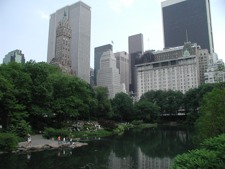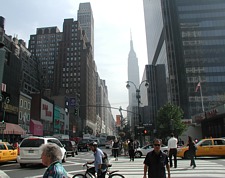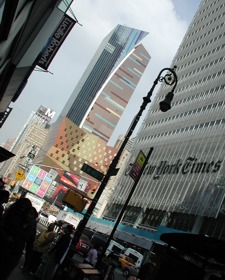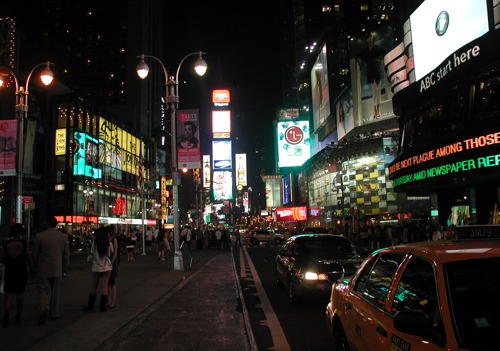[This travel article was published in the November 2007 issue of the Qatar-based feature magazine ‘New Era’.]
 It is late afternoon, and I’m writing this article on a muggy, fall day in New York City’s Central Park. I’m seated on patchy grass after finding myself a hotspot (thanks to free wi-fi in the park), catching up on e-mail and news. I arrived here on the comfortable Acela train from Boston, three and a half hours of super-smooth travel that skirted the Eastern seaboard with barely a whisper. Since my arrival, I’ve been drawn into a gritty, urban state of mind, while savouring the ability to keep walking for hours, being simultaneously assaulted and lulled by the sights and sounds of Manhattan. In contrast, the park is an anticlimax – a green cocoon of quiet; free of exhaust and the taut energy that wraps the avenues outside. The purpose of my visit? None really. I have no appointments to keep, no deadlines to meet. I’m staying at the New Yorker Hotel, in midtown Manhattan. Built in the art deco style of the jazz swing era, it was one of NYC’s premier hotels and hosted famous big bands such as those led by Benny Goodman and Woody Herman during its heyday. Unfortunately it stands in various states of disrepair today, but its location is hard to beat, offering an almost instant access to several key tourist spots and vistas in the city core. Situated a few blocks north is Times Square and Central Park, and to the South, Lower Manhattan and the Village with its interesting, funky neighbourhoods such as SoHo, Chelsea, Little Italy and Chinatown.
It is late afternoon, and I’m writing this article on a muggy, fall day in New York City’s Central Park. I’m seated on patchy grass after finding myself a hotspot (thanks to free wi-fi in the park), catching up on e-mail and news. I arrived here on the comfortable Acela train from Boston, three and a half hours of super-smooth travel that skirted the Eastern seaboard with barely a whisper. Since my arrival, I’ve been drawn into a gritty, urban state of mind, while savouring the ability to keep walking for hours, being simultaneously assaulted and lulled by the sights and sounds of Manhattan. In contrast, the park is an anticlimax – a green cocoon of quiet; free of exhaust and the taut energy that wraps the avenues outside. The purpose of my visit? None really. I have no appointments to keep, no deadlines to meet. I’m staying at the New Yorker Hotel, in midtown Manhattan. Built in the art deco style of the jazz swing era, it was one of NYC’s premier hotels and hosted famous big bands such as those led by Benny Goodman and Woody Herman during its heyday. Unfortunately it stands in various states of disrepair today, but its location is hard to beat, offering an almost instant access to several key tourist spots and vistas in the city core. Situated a few blocks north is Times Square and Central Park, and to the South, Lower Manhattan and the Village with its interesting, funky neighbourhoods such as SoHo, Chelsea, Little Italy and Chinatown.
 New York City has one of the highest land use densities in the world, and its street design and flow is based on the grid system, using straight lines and right angles. Parking in the city requires an investment of several hours a week, a cool and perseverant mind, and the likelihood of several parking tickets, which is why most residents prefer using public transportation or a bicycle. Nevertheless, it is a breeze to navigate the perpendicular geography of this walker’s city. The streets reflect the American ideal of a ‘melting pot’, and I overhear different tongues and accents as I pass by rows of closely packed shops, convenience stores and restaurants. A few blocks later, I am met with sweeping concrete towers of business and commercial edifices, laying testament to the fact that every neighbourhood has something different to offer, and the environment can change as rapidly as the change in the Avenue or street number.
New York City has one of the highest land use densities in the world, and its street design and flow is based on the grid system, using straight lines and right angles. Parking in the city requires an investment of several hours a week, a cool and perseverant mind, and the likelihood of several parking tickets, which is why most residents prefer using public transportation or a bicycle. Nevertheless, it is a breeze to navigate the perpendicular geography of this walker’s city. The streets reflect the American ideal of a ‘melting pot’, and I overhear different tongues and accents as I pass by rows of closely packed shops, convenience stores and restaurants. A few blocks later, I am met with sweeping concrete towers of business and commercial edifices, laying testament to the fact that every neighbourhood has something different to offer, and the environment can change as rapidly as the change in the Avenue or street number.
 I’m a great fan of street food, and beyond the predictable such as pretzels and hot dogs, there is an array of ethnic foods which has gone mainstream in New York. The past few years have seen a proliferation of mostly immigrant-owned stands selling kebabs, gyros and falafel, and the city even has a ‘Vendy awards’ that rewards the best carts in the city, while also acting as a union to provide the vendors a voice. Rahman, a beaming young man, originally hailing from Pakistan, had his cart stationed near the Rockefeller Center. Drawn by a mixture of hunger and enticing aromas, I purchased a couple of terrific chicken and lamb rice plates from him. Topped with a mysterious, but delicious white yoghurt sauce, the meat was succulent and infused with Eastern spices, the rice was long-grained basmati, redolent with delicate seasonings. There were more impromptu al fresco dining choices including Jamaican jerk chicken, South Indian dosas, barbequed pulled pork, French crepes and Mexican chili and burritos, but stuffed to the gills by now with Rahmans’ culinary offerings, I opted instead for a small paper bag of freshly roasted honey almonds to satisfy my sweet tooth.
I’m a great fan of street food, and beyond the predictable such as pretzels and hot dogs, there is an array of ethnic foods which has gone mainstream in New York. The past few years have seen a proliferation of mostly immigrant-owned stands selling kebabs, gyros and falafel, and the city even has a ‘Vendy awards’ that rewards the best carts in the city, while also acting as a union to provide the vendors a voice. Rahman, a beaming young man, originally hailing from Pakistan, had his cart stationed near the Rockefeller Center. Drawn by a mixture of hunger and enticing aromas, I purchased a couple of terrific chicken and lamb rice plates from him. Topped with a mysterious, but delicious white yoghurt sauce, the meat was succulent and infused with Eastern spices, the rice was long-grained basmati, redolent with delicate seasonings. There were more impromptu al fresco dining choices including Jamaican jerk chicken, South Indian dosas, barbequed pulled pork, French crepes and Mexican chili and burritos, but stuffed to the gills by now with Rahmans’ culinary offerings, I opted instead for a small paper bag of freshly roasted honey almonds to satisfy my sweet tooth.
A visit to the ongoing AES (Audio Engineering Society) convention at the Javits Center was a must – it is an annual event providing a meeting ground for the pro audio scientific elite and high profile manufacturers who shape the world of audio. More of an enthusiast than a participant, it was nevertheless fascinating to browse through the booths displaying recently announced products and offerings. A trip to the Blue Note jazz club (be prepared to share tables and be herded along with other strangers in a micro-space), and another to imbibe some refreshing sangria and tapas at a Spanish restaurant in the Village a little before midnight (seemingly, New York never sleeps) was an evening well spent. Times Square after dark was dazzling, a cacophony of voices and traffic, gigantic neon television screens that winked loudly at the swarms of locals and tourists below. I admit my noggin began to spin with the frenetic bustle and constant flashing of cameras around me. It was time to exit this spectacle and head back to the hotel.

It has been estimated that nearly half of all Americans today can trace their family history to at least one person who passed through the Port of New York, personifying NYC as the immigrant capital of the world. A quote by John Rockefeller, whose enormous influence is felt all over the city, sums up the spirit of New York best: “I believe in the dignity of labor, whether with head or hand; that the world owes no man a living but that it owes every man an opportunity to make a living.”
Ramona Borthwick is a jazz pianist who was classically trained. She lives in Boston, MA where she performs and teaches. Visit her on the web at: www.ramonaborthwick.com.
